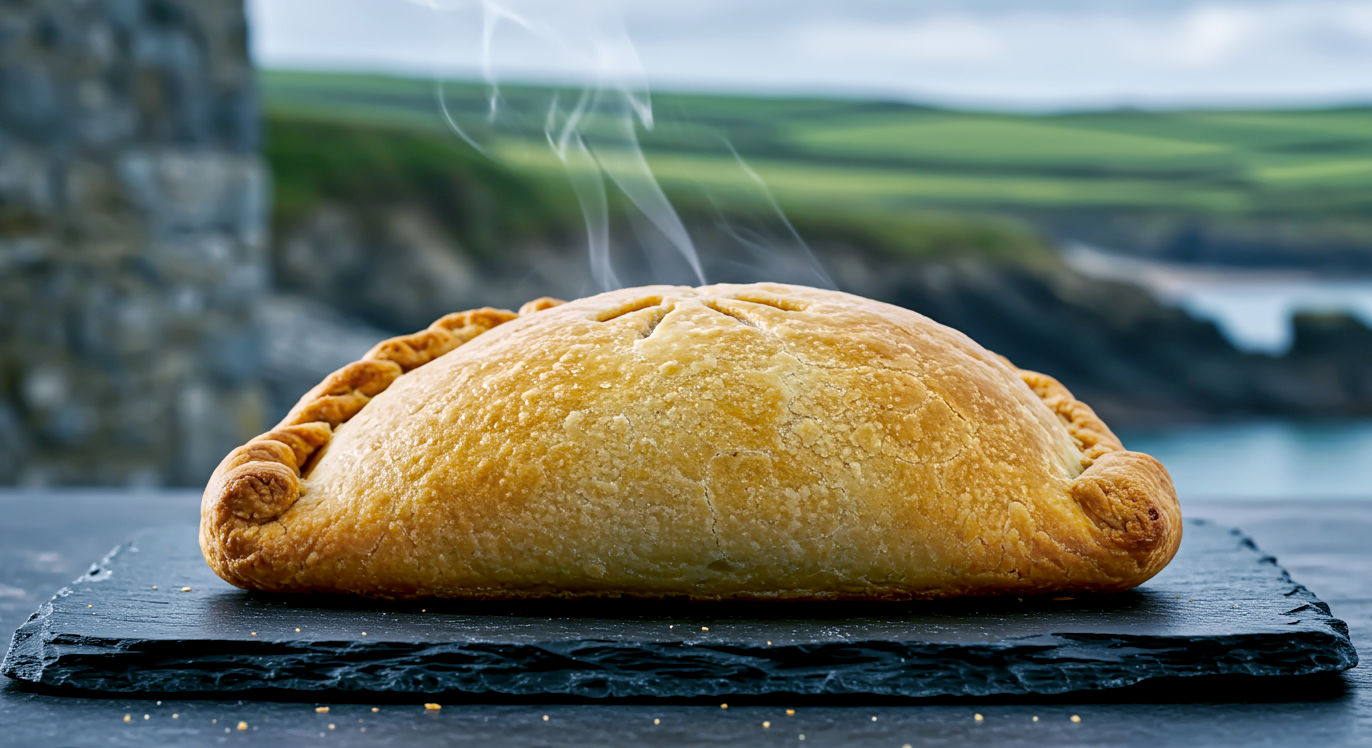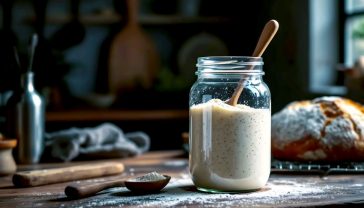Cornish Pasties: An Historic Love Affair
From the tin mines of Cornwall to a legally protected British icon. Explore the fascinating story, recipe, and cultural legacy of the Cornish pasty.

This post may contain affiliate links. If you make a purchase through these links, we may earn a commission at no additional cost to you.
If you’ve ever held a proper Cornish pasty, you know it’s more than just a bit of lunch. It’s a warm, weighty parcel of history you can hold in one hand. With its golden, crimped crust and savoury filling, the pasty isn’t just Cornwall’s most famous export; it’s a symbol of a tough, resourceful way of life that has fed families for centuries. It tells a story of tin miners, fishermen, and farmers, of wives packing hearty meals for their husbands to take deep into the earth or out to sea.
But how did this humble D-shaped pie become such a beloved icon of British food? It’s a tale that stretches from the lavish tables of medieval kings right down to the dark, damp tunnels of Cornwall’s tin mines. It’s about a simple, practical meal that became protected by law, celebrated in festivals, and loved by millions across the country and, indeed, the world.
Forget the pale, floppy imitations you might find in a motorway service station. We’re going on a journey to uncover the story of the real Cornish pasty. We’ll dig into its fascinating history, learn exactly what makes a pasty ‘proper,’ and discover why this simple bake continues to hold such a special place in Britain’s heart. So, grab a cup of tea, get comfortable, and let’s bite into the rich story of the Cornish pasty.
What Exactly Is a Cornish Pasty?
Before we get carried away, let’s get one thing straight: not every pasty is a Cornish pasty. Far from it. A true Cornish pasty is a masterpiece of simple, effective food design, perfected over generations. Think of it as the original all-in-one meal, perfectly engineered for a working man’s lunch.
At its heart, a proper pasty is a sturdy, savoury pastry case filled with uncooked beef, potato, swede (which, crucially, is called turnip in Cornwall), and onion. These ingredients are layered inside a circle of pastry, which is then folded in half to create its famous D-shape. The magic happens in the oven. As the pasty bakes, the juices from the beef and vegetables create a rich, delicious gravy that cooks the filling to perfection.
The result is a self-contained meal. The pastry is firm enough to be held without falling apart, while the inside is tender and steaming. It didn’t need a plate or cutlery, making it the perfect handheld lunch for a miner deep underground.
The Anatomy of a Pasty: Built for Purpose
Every part of a Cornish pasty has a reason for being there. It’s a brilliant piece of culinary engineering.
The Pastry: A Sturdy Case
The pastry isn’t the flaky, delicate stuff you’d find on a sausage roll. It’s a strong, shortcrust pastry made with a higher fat content, traditionally using lard or suet. This makes it tough enough to survive a journey down a mine shaft in a worker’s pocket without crumbling. It’s there to be a robust, edible container for the filling inside. It’s a vessel first, and a delicious part of the meal second.
The Filling: The Holy Trinity (Plus Beef)
The traditional filling is beautifully simple:
- Beef: Typically skirt steak, a cheap but flavourful cut of beef. It’s chopped or minced, never in big chunks, so it cooks evenly.
- Potato: Sliced thinly to cook through in the steam and soak up the meaty gravy.
- Swede: This is the controversial one! In Cornwall, they call it turnip. It adds a slightly sweet, earthy flavour that cuts through the richness of the beef.
- Onion: Finely chopped to add a savoury depth to the filling.
These ingredients are seasoned simply with salt and pepper. That’s it. No carrots, no peas, no fancy herbs. Just honest, hearty ingredients that together create something truly special.
The Crimp: A Signature Seal and a Handle
The most iconic feature of a Cornish pasty is its crimped edge, which runs along the curved side of the ‘D’. This isn’t just for decoration. The crimp is a vital part of the pasty’s structure, sealing the filling tightly inside so none of the precious gravy can escape during baking.
There’s also a popular legend about the crimp. It’s said that miners, whose hands would be covered in arsenic-laced dust from the tin ore, would hold the pasty by its thick, crimped edge. This part acted as a disposable handle. After they’d eaten the main body of the pasty, they would throw the crust away, avoiding any risk of poisoning. While some historians debate how widespread this practice was, it’s a brilliant story that highlights just how perfectly the pasty was suited to a miner’s life.
Protected by Law: What is PGI Status?
The Cornish pasty is so important to Cornwall’s identity that it has been given special legal protection. In 2011, it was awarded Protected Geographical Indication (PGI) status by the European Union, a protection that has been carried over into UK law after Brexit.
This is a really big deal. It means that a pasty can only be called a ‘Cornish pasty’ if it’s made in Cornwall to a specific recipe and method. It’s the same kind of protection that’s given to other famous regional foods, like Champagne from France or Parmesan cheese from Italy.
So, what are the rules? To be a genuine Cornish pasty, it must:
- Be made in Cornwall. The entire process, from making the pastry to filling and baking it, has to happen within the county.
- Have the classic D-shape. No triangles, squares, or ovals allowed.
- Be crimped on the side, not on top. This is a key detail that separates it from pasties made in neighbouring Devon.
- Contain the traditional filling of roughly minced or diced beef, sliced potato, swede, and onion. There has to be at least 12.5% beef and 25% vegetables.
- The filling must be raw when the pasty is assembled. The ingredients cook together inside the pastry.
- The pastry must be golden and robust, able to hold its shape.
This PGI status protects the heritage of the Cornish pasty. It ensures that when you buy one, you’re getting the real deal, made with care by people who understand its history and tradition. It stops big companies from mass-producing cheap imitations and passing them off as authentic. It’s a mark of quality and a promise of a true taste of Cornwall.
A Journey Through Time: The History of the Pasty
While we think of the pasty as a Cornish miner’s lunch, its history is actually much longer and more distinguished. The idea of baking a filling inside a pastry case is an ancient one, but the pasty as we know it has a story that’s deeply woven into the fabric of British life, from the royal court to the working class.
From Royal Feasts to Humble Homes
Believe it or not, the pasty’s ancestors were once food for the rich and powerful. In medieval times, cooks for the nobility would create elaborate ‘grete pyes’ filled with all sorts of expensive ingredients like venison, swan, and seafood. The thick pastry case, often decorated, was called a ‘huff’ and wasn’t always meant to be eaten. Its main job was to act as a container to keep the filling moist during its long cooking time in the oven.
References to these early pasties pop up in historical records. There’s a letter from a baker to Henry VIII’s third wife, Jane Seymour, in 1537 that mentions “a pece of a pastie of red dere.” Even Shakespeare gets in on the act, with a character in The Merry Wives of Windsor exclaiming, “Come, we have a hot pasty to dinner!”
These were not the humble pasties of the Cornish tin mines. They were a sign of wealth, a centrepiece for a lavish banquet. But over time, as ingredients like flour and meat became more affordable, the pasty began to find its way onto the tables of ordinary folk.
The Pasty Finds Its True Home: Cornwall’s Tin Mines
The 18th and 19th centuries were the boom years for Cornwall’s mining industry. The county was the world’s leading producer of tin and copper, and thousands of men and boys worked long, hard shifts deep underground in hot, dangerous conditions. They needed a lunch that was cheap, filling, and easy to eat. The pasty was the perfect solution.
It was the ultimate convenience food. A miner’s wife would bake pasties in the morning, and they would still be warm by lunchtime, insulated by their thick pastry crust. They were packed with calories, providing the energy needed for a day of back-breaking physical labour. And, of course, they could be eaten with one hand, leaving the other free to hold a tool or a candle.
This is where the pasty became the icon we know today. It was shaped by the needs of the Cornish miner. The ingredients were what families could afford or grow themselves: potatoes and swedes from their own small plots of land, and cheap cuts of beef. It was a food born of necessity and ingenuity.
Sweet and Savoury: The Two-in-One Pasty?
One of the most enduring legends about the Cornish pasty is the idea of the ‘two-course’ pasty. The story goes that one end of the pasty would be filled with the traditional savoury mixture, while the other end would contain a sweet filling, like apple or jam. This meant a miner could have his main course and dessert all in one handy package.
It’s a lovely idea, and it’s certainly possible that some wives did this as a special treat for their husbands. However, food historians now think this was probably not a common practice. Most pasties were purely savoury. But the legend persists because it adds to the pasty’s mystique and its reputation as a wonderfully practical meal.
The Cornish Diaspora: Taking the Pasty to the World
In the late 19th century, the Cornish mining industry began to decline. Cheaper tin was being discovered in other parts of the world, and many Cornish mines were forced to close. This led to a mass emigration of skilled Cornish miners, who took their expertise—and their love for pasties—all over the globe.
This migration is sometimes called the ‘Cornish Diaspora’. Cornish miners and their families settled in places like the United States (particularly Michigan and California), Australia, South Africa, and Mexico. Wherever they went, they brought their traditions with them, and the Cornish pasty was one of the most important.
In some of these places, the pasty put down new roots and evolved. In the Upper Peninsula of Michigan, for example, the ‘pasty’ (pronounced pass-tee) is still a hugely popular local dish, introduced by Cornish miners who came to work in the copper mines. In Mexico, the Cornish miners of Hidalgo are credited with inspiring the local ‘pastes’, which are often filled with spicy, local ingredients.
So, the Cornish pasty isn’t just a local delicacy. It’s a global food, a reminder of a time when Cornish families travelled thousands of miles to find work and build new lives, with the taste of home packed in their luggage.
The Great Pasty Debate: Cornwall vs. Devon
Every food-loving nation has its great rivalries. In Britain, one of the fiercest is the friendly war between Cornwall and Devon. It’s a battle fought over the correct way to make a cream tea (jam or cream first?) and, of course, the proper way to make a pasty.
The people of Devon, Cornwall’s neighbours to the east, also have a long and proud history of pasty-making. They claim their pasty tradition is just as old and just as authentic. But there are a few key differences that a true pasty connoisseur can spot a mile off.
Crimp on Top or on the Side?
The most obvious difference is the crimp. A Cornish pasty is always crimped on the side, forming a thick rope-like crust along the curve of the D. A Devon pasty, on the other hand, is usually crimped on top, creating a ridge that runs down the middle.
To the outsider, this might seem like a minor detail. But to the people of Cornwall and Devon, it’s a matter of fierce regional pride. Each side insists their method is the original and best way to do it.
Chopped or Minced? Diced or Sliced?
There are also subtle differences in the filling. While both use the same core ingredients, Cornish tradition dictates that the meat should be roughly minced or finely chopped, and the vegetables should be sliced. In Devon, it’s more common to find the meat and vegetables all diced into small, uniform cubes.
The Cornish argue that their method allows the flavours to meld together better during cooking, creating that all-important gravy. The Devonians might counter that their dicing method ensures a more consistent bite.
Who Gets the Credit?
The truth is that both counties have been making pasties for centuries. The pasty was a practical food for farmers, fishermen, and miners all across the South West of England. It wasn’t confined by county borders.
However, it was in Cornwall that the pasty became truly famous, thanks to its deep connection with the tin mining industry. It was the Cornish miners who perfected the pasty as a working man’s lunch and who spread its fame around the world. And it’s Cornwall that has successfully fought to protect the pasty’s name and heritage with its PGI status.
So, while Devon certainly makes a fine pasty, it is the Cornish pasty that has captured the world’s imagination and become a true British food icon.
How to Make a Proper Cornish Pasty: A Step-by-Step Guide
Making your own Cornish pasties is a deeply rewarding experience. There’s nothing quite like the smell of them baking in the oven, and the taste of a fresh, homemade pasty is a world away from a shop-bought one.
The key to a great pasty is not to overcomplicate things. It’s about using good, simple ingredients and following the traditional method. This recipe will give you four large pasties, perfect for a hearty lunch.
The Ingredients
For the Pastry:
- 500g strong white bread flour (it gives the pastry strength)
- 125g lard, cold and cubed
- 125g butter, cold and cubed
- 1 teaspoon of salt
- About 150ml of cold water
For the Filling:
- 400g good quality beef skirt, trimmed of any gristle and finely chopped
- 1 large onion (about 200g), finely chopped
- 1 large potato (about 250g), peeled and thinly sliced
- 150g swede (remember, in Cornwall it’s a turnip!), peeled and thinly sliced
- Salt and freshly ground black pepper
- A little butter (optional, for richness)
- 1 egg, beaten, to glaze
The Method
Step 1: Make the Pastry
This is the foundation of your pasty, so it’s worth doing it right.
- In a large bowl, mix the flour and salt together.
- Add the cold, cubed lard and butter to the flour. Using your fingertips, rub the fat into the flour until the mixture looks like breadcrumbs. Work quickly so the fat doesn’t melt.
- Gradually add the cold water, mixing with a knife until the dough starts to come together. You might not need all the water. You want a firm, not sticky, dough.
- Tip the dough onto a lightly floured surface and knead it very gently for just a minute until it’s smooth. Don’t overwork it, or the pastry will be tough.
- Wrap the dough in cling film and let it rest in the fridge for at least 30 minutes. This lets the gluten relax and makes the pastry easier to roll.
Step 2: Prepare the Filling
While the pastry is resting, get your filling ready.
- Get three separate bowls. Put the chopped beef in one, the sliced potato and swede in another, and the chopped onion in the third.
- Season the beef generously with salt and pepper. It’s important to season the layers as you go.
Step 3: Assemble the Pasties
This is the fun part!
- Preheat your oven to 200°C (180°C Fan / Gas Mark 6). Line a large baking tray with baking parchment.
- Divide your chilled pastry into four equal pieces. On a floured surface, roll out one piece of pastry into a circle, roughly the size of a dinner plate (about 25cm in diameter).
- Now, you’re going to build the filling on one half of the pastry circle, leaving a clear margin of about 2cm around the edge.
- Start with a layer of potato and swede, then a layer of onion, and then a layer of the seasoned beef. Season this layer with a little more salt and pepper. Repeat the layers until you’ve used up a quarter of your filling, finishing with a layer of potato and swede. You can add a small knob of butter on top if you like, for extra richness.
- Brush the clear edge of the pastry with a little of the beaten egg.
- Carefully fold the empty half of the pastry over the filling to create the D-shape. Press the edges together firmly to seal them.
Step 4: Crimp and Bake
The signature finish.
- To crimp the pasty, start at one corner. Use your thumb and forefinger to twist the edge of the pastry over on itself, creating a rope-like effect. Continue this all the way along the curved edge. Don’t worry if it’s not perfect the first time – practice makes perfect!
- Place the assembled pasty on the prepared baking tray. Brush it all over with the beaten egg to give it a lovely golden glaze. Make a small slit in the top of the pasty to let the steam escape.
- Repeat the assembly and crimping process with the remaining three pieces of pastry and filling.
- Bake the pasties in the preheated oven for 20 minutes. Then, reduce the oven temperature to 160°C (140°C Fan / Gas Mark 3) and continue to bake for another 30-40 minutes, until the pastry is golden brown and the filling is cooked through.
- Once baked, let the pasties cool on the tray for at least 10 minutes before eating. This allows the flavours to settle. They are delicious eaten warm, but also very good cold.
The Pasty in the 21st Century: Tradition and Innovation
The Cornish pasty has come a long way from its humble beginnings. Today, it’s big business. The Cornish pasty industry is worth an estimated £300 million a year to the Cornish economy, and it supports thousands of jobs. It’s a source of immense pride and a vital part of the county’s identity.
Walk down any high street in Cornwall, and you’ll be greeted by the delicious smell of baking pasties wafting from bakeries. Famous names like Greggs and Ginsters have taken their own versions of the pasty to a national audience, but in Cornwall, it’s the small, independent, family-run bakeries that are the heart and soul of the pasty world.
The World Pasty Championships
The love for the pasty is celebrated every year at the World Pasty Championships, held at the Eden Project in Cornwall. It’s a wonderful, quirky event that brings together amateur and professional pasty-makers from all over the world to compete for the coveted title of World Pasty Champion.
Competitors enter their pasties into different categories, including the traditional Cornish pasty class (which is judged very strictly on the PGI rules) and an open savoury class, where the creativity runs wild. You might find pasties filled with anything from chicken tikka to vegan chilli. It’s a brilliant celebration of the pasty’s heritage and its ability to adapt and evolve.
Beyond the Traditional: Modern Pasty Fillings
While the traditional beef pasty will always be king, modern bakers have embraced new flavours to cater for all tastes. You can now find a huge variety of fillings, including:
- Cheese and Onion: A classic vegetarian option.
- Steak and Ale: Using local Cornish ale for a rich, malty gravy.
- Chicken and Vegetable: A lighter alternative to beef.
- Vegan and Gluten-Free: Specialist bakeries now cater for different dietary needs, creating delicious pasties that everyone can enjoy.
These modern variations show that the pasty is not stuck in the past. It’s a versatile food that can be adapted to suit contemporary tastes, while still honouring the spirit of the original.
A Lasting Legacy: Why We Still Love the Cornish Pasty
The Cornish pasty is more than just a food. It’s a cultural artefact. It’s a direct link to Britain’s industrial past, a time of hard labour, close-knit communities, and incredible resilience. To eat a Cornish pasty is to take a bite of that history.
It represents the very best of British food: simple, unpretentious, and made with good, honest ingredients. It wasn’t invented by a celebrity chef in a fancy restaurant. It was created out of necessity by ordinary people, for ordinary people. It was designed to be filling, portable, and delicious, and it still ticks all those boxes today.
Its story is one of survival and adaptation. It has gone from a miner’s lunch to a national treasure, from the depths of the earth in Cornwall to supermarket shelves across the country. It has travelled the world and inspired new culinary traditions.
And yet, at its heart, it remains unchanged. A warm, golden crescent of pastry, filled with beef and vegetables, seasoned with nothing more than salt, pepper, and centuries of history. It is a symbol of home, of comfort, and of the enduring spirit of Cornwall. Long may it reign.
Further Reading
For those interested in delving deeper into the history and culture of the Cornish pasty, here are some highly respected resources:
- The Cornish Pasty Association: The official body representing Cornish pasty producers. Their website is a treasure trove of information on the history and PGI status of the pasty. https://cornishpastyassociation.co.uk/
- Cornwall For Ever!: A fantastic online resource for all things related to Cornish culture and history, with detailed articles on the origins of the pasty. https://www.cornwallforever.co.uk/
- English Heritage: Their blog often features articles on the history of British food, including the role of the pasty in our culinary heritage. https://www.english-heritage.org.uk/






